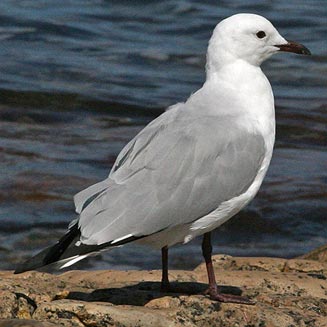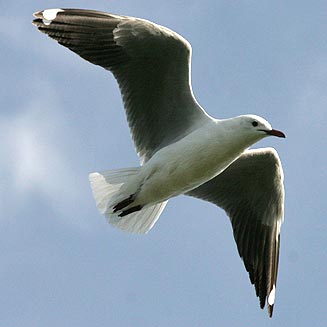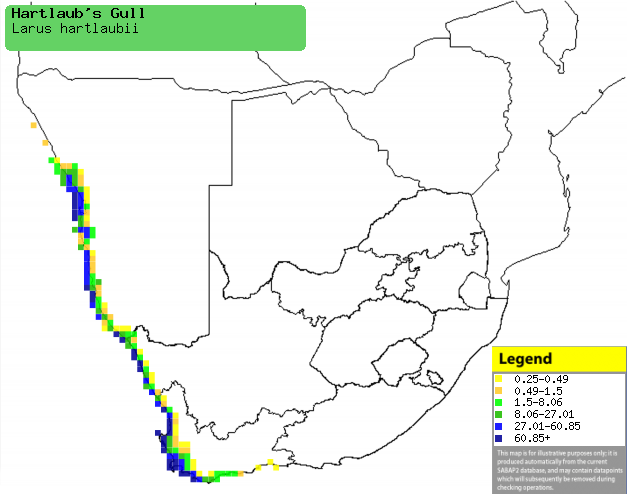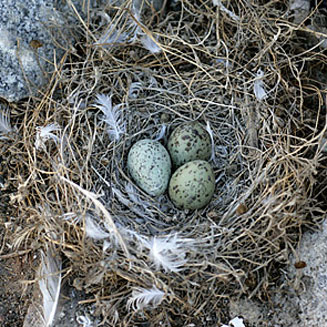|
Larus hartlaubii
(Hartlaub's Gull)
Hartlaubse meeu [Afrikaans]; Sterretjie [Afrikaans];
Mouette de Hartlaub [French]; Hartlaubsmöwe, Weißkopflachmöwe [German];
Gaivota de Hartlaub [Portuguese]
Life
> Eukaryotes >
Opisthokonta
> Metazoa (animals) >
Bilateria >
Deuterostomia > Chordata >
Craniata > Vertebrata (vertebrates) > Gnathostomata (jawed
vertebrates) > Teleostomi (teleost fish) > Osteichthyes (bony fish) > Class:
Sarcopterygii (lobe-finned
fish) > Stegocephalia (terrestrial
vertebrates) > Tetrapoda
(four-legged vertebrates) > Reptiliomorpha > Amniota >
Reptilia (reptiles) >
Romeriida > Diapsida > Archosauromorpha > Archosauria >
Dinosauria
(dinosaurs) > Saurischia > Theropoda (bipedal predatory dinosaurs) >
Coelurosauria > Maniraptora > Aves
(birds) > Order: Charadriiformes
> Family: Laridae > Genus: Larus
 |
 |
| Hartlaub's gull, Cape Peninsula
National Park, Western Cape, South Africa. [photo
Duncan Robertson ©] |
Hartlaub's gull, Strandfontein Sewerage Works,
Western Cape, South Africa. [photo
Duncan Robertson ©] |
Distribution and habitat
Endemic to southern Africa, occurring along of the coast of
Namibia (up to Cape Cross) and the Northern and Western Cape, largely coinciding
with the distribution of the kelps Laminaria pallida and Ecklonia
maxima. It generally prefers coastal habitats, especially if disturbed by
human activity, in fact approximately half of its population occurs in man-made
areas.
|
 |
|
Distribution of Hartlaub's gull in southern Africa,
based on statistical smoothing of the records from first SA Bird Atlas
Project (©
Animal Demography unit, University of
Cape Town; smoothing by Birgit Erni and Francesca Little). Colours range
from dark blue (most common) through to yellow (least common).
See here for the latest distribution
from the SABAP2. |
Predators and parasites
- Predators
- of adults
- of eggs
- of chicks
- of eggs and chicks
- Parasites
- shistosomes
- Austrobilharzia
- Gigantobilharzia
Movements and migrations
Generally sedentary, although juveniles from
island colonies disperse across the sea to the mainland.
Food
It mainly eats fish and aquatic invertebrates, doing most
of its foraging by seizing prey from the water surface while swimming,
plunge-diving, scavenging in the wake of trawlers, plucking food from the ground
or hawking termite alates aerially. The following food items have been recorded
in its diet:
- Vertebrates
- fish
- Lampanyctodes hectoris (Lantern fish)
- Sugglogobius bibarbatus (Pelagic goby)
- Engraulis encrasicolus (Cape anchovy)
- Sardinops sagax (Sardine)
- Merluccius (hakes)
- Thrysites atun (Snoek)
- eggs
-
Bradypodium pumilum (Cape dwarf chameleon)
- Invertebrates
- Nereis (polychaetes)
- molluscs
- Sepia australis (Southern cuttlefish)
- Tricolia capensis (Pheasant shell)
- Fissurella mutabilis (Cape keyhole limpet)
- Nodolittorina africana (African periwinkle)
- Dendrofissurella scutella (Saddle-shaped keyhole limpet)
- Donax serra (White mussel)
- Mytilus galloprovincialis (Mediterranean mussel)
- arthropods
- Talorchestia capensis (Beach hopper)
- Ligia glabrata (Sea-slater)
- Deto echinata (Horned isopod)
- Paridotea reticulata (Reticulate kelp louse)
- Upogebia capensis (Coastal mudprawn)
- Jasus lalandii (West coast rock lobster)
- Plagusia chabrus (Cape rock crab)
- Ovalipes trimaculatus (Three-spot swimming crab)
- insects
- earthworms
- Other
- domestic waster (of plants and animals)
- fruit of low-growing shrubs
Breeding
- Monogamous colonial nester, with each pair defending a small territory
around the nest, defending it by performing aggressive displays.
- The nest (see image below) is an untidy bowl of plant stems, typically
placed on rocky ground or alternatively among reeds or on a man-made
structure, such as guano platforms, buildings, roofs, dam walls and flower
pots.
 |
|
|
Hartlaub's gull nest with eggs, Velddrif, South
Africa. [photo
Warwick Tarboton ©] |
|
- Egg-laying season is mainly from March-June in Namibia, and from
January-October, peaking from February-April in the Western Cape, although
it may breed at any time of year depending on environmental conditions.
- It lays 1-3 eggs, which are incubated by both sexes for about 25 days.
- The chicks are fed by both parents by regurgitation; if a snake
approaches the young, the adults attack the intruder.
Threats
Not threatened, in fact its population greatly increased
due to human disturbance, although it is now thought to be either stable or decreasing.
References
-
Hockey PAR, Dean WRJ and Ryan PG 2005. Roberts
- Birds of southern Africa, VIIth ed. The Trustees of the John Voelcker
Bird Book Fund, Cape Town.
|
